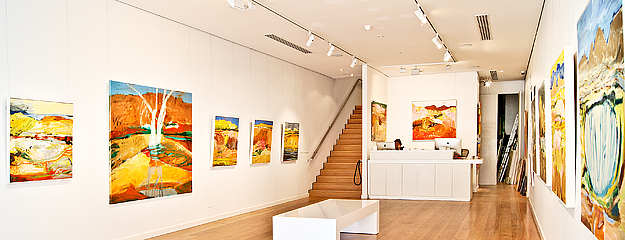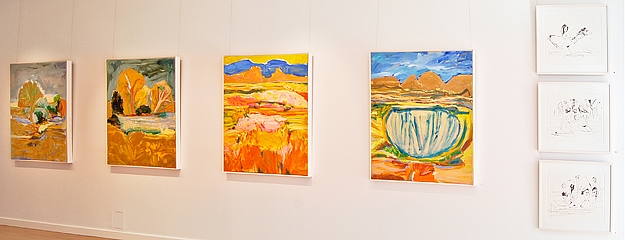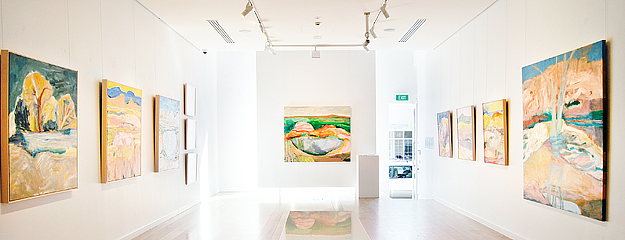Exhibitions
Jo Bertini
Tim Olsen Gallery
24 April - 13 May 2012
Jo Bertini
The Desert Garden
Tim Olsen Gallery
24 April - 13 May 2012
Please note: Works may no longer be available as shown and prices may be subject to change to reflect current market value. Please contact the gallery for assistance. Thank you
Jo Bertini - The Desert Garden
A picture must be fertile. It must give birth to a world.
Joan Miró
It has taken a long time for us, Europeans in the land of Australia, to come around to the idea of the desert as a garden. In the beginning and for a long time afterwards the idea of Australia having a ‘dead heart’ coloured our thinking. When artists travelled into the interior they saw a barren landscape. Even long after hopes of a fertile inland had evaporated, artists wanted the desert to be a valley of dry bones. An artist like Hans Heysen was typical. In 1926 he left cultivated, rural Hahndorf and went into the Flinders Ranges where he found landscapes of big severe forms, redolent of vast age, and simple colour. Yet when Heysen returned to the Flinders in 1928, after rain, he found the abundant growth of grass ‘disconcerting’. He did not know how to paint a desert in bloom – he couldn’t see a way to paint the desert garden.
In the 1970s we began to see the desert garden. The great inundations of water into the Lake Eyre Basin created a cyclical outburst of life and provided naturalists with unique opportunities to share this spectacle with the wider world. The flood of 1974 was the beginning of John Olsen’s four-decade fascination with Lake Eyre’s cycle’s of abundance and dormancy that has produced such profound paintings and drawings in his oeuvre.
In the 1970s, too, Aboriginal artists came out of the Western Desert, sharing a view of the landscape full of detail, incident, life-giving stories. What had previously looked to many European eyes as monotony could now be seen as full of meaning and rich in detail. This ‘flowering’ of Aboriginal painting in the interior has continued to provide images of astonishing power, originality and colour.
It is only possible to paint the desert with knowledge. You cannot just dip into the desert and hope to see it. Jo Bertini has been very fortunate in going into the desert repeatedly, and in the company of men and women who have deep knowledge of many aspects of its natural and human histories. She has known the desert as a dry place and has understood its detail. She has known it and studied it in these past few years when La Niña has visited the life-giving rain on the interior. She has travelled deep into the land and has studied the flora with the attention of a botanist. The Desert Garden is her response to the experience of the flowering of the desert.
The first thing that strikes you about these paintings is their colour – joyous colour, intense and rich. You could say this is saturated colour, echoing the other meaning of saturated - ‘soaked’.
The artist shares her dazzlement with us – shares her experience of seeing. At times she layers tone and colour to evoke the glowing shadows of the evening; at other times she puts down colour with the uncomplicated directness of the desert landscape itself. There is an energy in her brush that corresponds with the emotional response to this landscape.
Thick and thin: in the desert there seems always to be a pull between sparseness and density. This is cyclical – you see it over the course of a day, or over the course of seasons. You notice it as the difference between the dunes and the swales between, between one dune and the next - though in the wake of prolonged rainfall everything is thickened, the dunes covered with flowering plants.
Sometimes, paintings of the interior of Australia give one the feeling that the language that artists have brought to it is inadequate. Yet I never feel this way with Jo Bertini’s work. She takes us with her and invites us to sit down beside her in the dunes as she discovers visual equivalents for experience. Her paintings feel like a conversation about the desert – one in which we partake, a shared journey of discovery.
She shows us the landscape but also, importantly, the means of travel into it – the trusty camels. They become part of her world in the desert. In the enigmatic self-portrait in this exhibition the three elements are brought together – the artist, the colour of the desert and the presence of the camel.
Has there been an Australian artist who has been so engaged with the camel as a subject as Jo Bertini? Her paintings of camels are undoubtedly portraits, in which she captures the individual characteristics and personalities of these creatures. The Women’s waterhole drawings record an event when the women of the expedition party were bathing at the end of the day and were joined at the waterhole by the camels, left free to graze after their day’s work.
This spontaneous occurrence, the camels coming up close to the bathing women, becomes a symbol of the natural relationship between women and the desert landscape, a theme as old as story itself. But it also records a simple truth: moisture, where water collects, is the source of all life - and of art.
For me, two key works in this exhibition are the beautiful evening and morning views of the Pulchera Waterhole. Both of these paintings have a dense watery sky that comes down into the waterhole and that, in turn, brings the changing sky down into the earth. From that exchange of light and earth and water, plants burst upward and push sideways. We feel the energy of that exchange.
And, as in every painting Jo Bertini has made of the desert garden, colour wants to overflow the confines of the canvas and run through the desert, carrying life.
Andrew Sayers
Director
National Museum of Australia
Art Historian, Writer
A picture must be fertile. It must give birth to a world.
Joan Miró
It has taken a long time for us, Europeans in the land of Australia, to come around to the idea of the desert as a garden. In the beginning and for a long time afterwards the idea of Australia having a ‘dead heart’ coloured our thinking. When artists travelled into the interior they saw a barren landscape. Even long after hopes of a fertile inland had evaporated, artists wanted the desert to be a valley of dry bones. An artist like Hans Heysen was typical. In 1926 he left cultivated, rural Hahndorf and went into the Flinders Ranges where he found landscapes of big severe forms, redolent of vast age, and simple colour. Yet when Heysen returned to the Flinders in 1928, after rain, he found the abundant growth of grass ‘disconcerting’. He did not know how to paint a desert in bloom – he couldn’t see a way to paint the desert garden.
In the 1970s we began to see the desert garden. The great inundations of water into the Lake Eyre Basin created a cyclical outburst of life and provided naturalists with unique opportunities to share this spectacle with the wider world. The flood of 1974 was the beginning of John Olsen’s four-decade fascination with Lake Eyre’s cycle’s of abundance and dormancy that has produced such profound paintings and drawings in his oeuvre.
In the 1970s, too, Aboriginal artists came out of the Western Desert, sharing a view of the landscape full of detail, incident, life-giving stories. What had previously looked to many European eyes as monotony could now be seen as full of meaning and rich in detail. This ‘flowering’ of Aboriginal painting in the interior has continued to provide images of astonishing power, originality and colour.
It is only possible to paint the desert with knowledge. You cannot just dip into the desert and hope to see it. Jo Bertini has been very fortunate in going into the desert repeatedly, and in the company of men and women who have deep knowledge of many aspects of its natural and human histories. She has known the desert as a dry place and has understood its detail. She has known it and studied it in these past few years when La Niña has visited the life-giving rain on the interior. She has travelled deep into the land and has studied the flora with the attention of a botanist. The Desert Garden is her response to the experience of the flowering of the desert.
The first thing that strikes you about these paintings is their colour – joyous colour, intense and rich. You could say this is saturated colour, echoing the other meaning of saturated - ‘soaked’.
The artist shares her dazzlement with us – shares her experience of seeing. At times she layers tone and colour to evoke the glowing shadows of the evening; at other times she puts down colour with the uncomplicated directness of the desert landscape itself. There is an energy in her brush that corresponds with the emotional response to this landscape.
Thick and thin: in the desert there seems always to be a pull between sparseness and density. This is cyclical – you see it over the course of a day, or over the course of seasons. You notice it as the difference between the dunes and the swales between, between one dune and the next - though in the wake of prolonged rainfall everything is thickened, the dunes covered with flowering plants.
Sometimes, paintings of the interior of Australia give one the feeling that the language that artists have brought to it is inadequate. Yet I never feel this way with Jo Bertini’s work. She takes us with her and invites us to sit down beside her in the dunes as she discovers visual equivalents for experience. Her paintings feel like a conversation about the desert – one in which we partake, a shared journey of discovery.
She shows us the landscape but also, importantly, the means of travel into it – the trusty camels. They become part of her world in the desert. In the enigmatic self-portrait in this exhibition the three elements are brought together – the artist, the colour of the desert and the presence of the camel.
Has there been an Australian artist who has been so engaged with the camel as a subject as Jo Bertini? Her paintings of camels are undoubtedly portraits, in which she captures the individual characteristics and personalities of these creatures. The Women’s waterhole drawings record an event when the women of the expedition party were bathing at the end of the day and were joined at the waterhole by the camels, left free to graze after their day’s work.
This spontaneous occurrence, the camels coming up close to the bathing women, becomes a symbol of the natural relationship between women and the desert landscape, a theme as old as story itself. But it also records a simple truth: moisture, where water collects, is the source of all life - and of art.
For me, two key works in this exhibition are the beautiful evening and morning views of the Pulchera Waterhole. Both of these paintings have a dense watery sky that comes down into the waterhole and that, in turn, brings the changing sky down into the earth. From that exchange of light and earth and water, plants burst upward and push sideways. We feel the energy of that exchange.
And, as in every painting Jo Bertini has made of the desert garden, colour wants to overflow the confines of the canvas and run through the desert, carrying life.
Andrew Sayers
Director
National Museum of Australia
Art Historian, Writer


